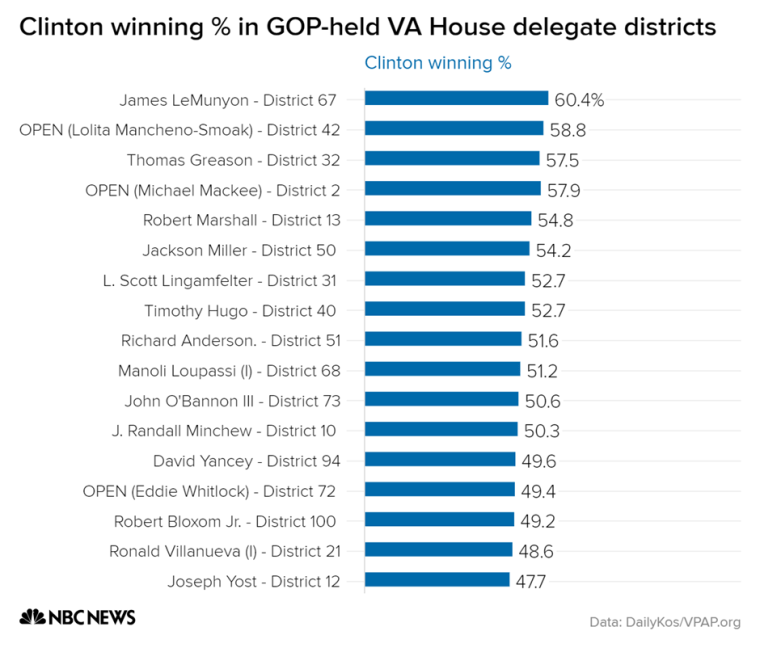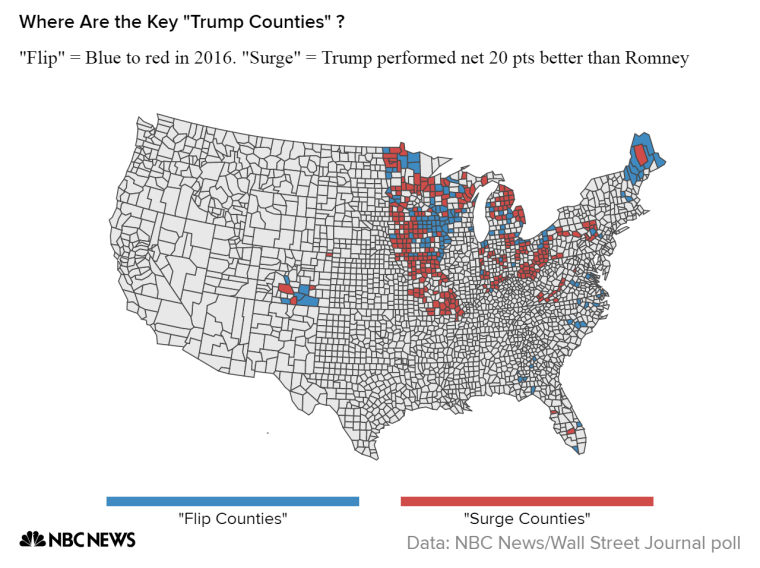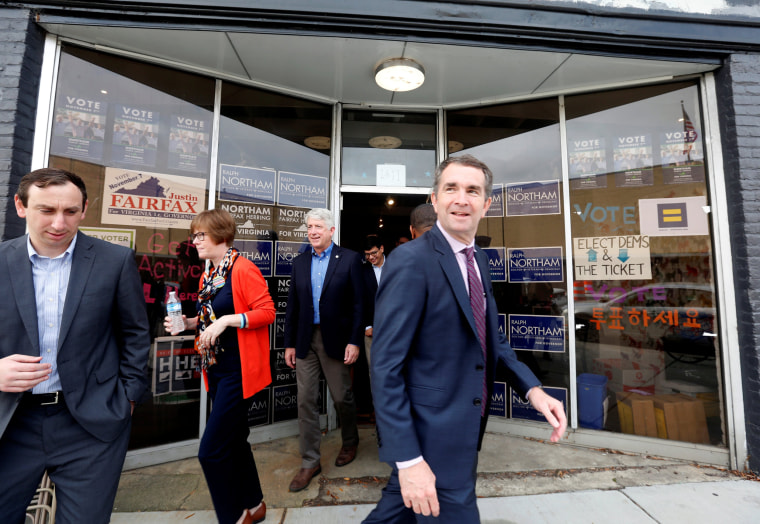First Read is your briefing from Meet the Press and the NBC Political Unit on the day's most important political stories and why they matter.
WASHINGTON — This feels like the most consequential off-year election we’ve seen since 1993, when Republicans Rudy Giuliani (in New York), Christine Todd Whitman (in New Jersey) and George Allen (in Virginia) all won, foreshadowing what would happen in the 1994 midterms the next year.
Every political strategist is watching tonight’s Virginia gubernatorial contest, which likely will come down to this question: What’s the more powerful force — the political environment (which looks rough for President Trump and the GOP) or campaign tactics (like Republican Ed Gillespie’s tough TV ads against Democrat Ralph Northam)?
Northam has tried to capitalize on the environment, especially given President Trump’s job rating in the 30s in the state. He’s tied Trump to Gillespie (“Ed Gillespie supports Donald Trump’s plan to take health care away from thousands of Virginians,” a Northam ad goes), and has tried to fire up Democrats still bruised by the fallout from 2016.
Gillespie, meanwhile, has run the more aggressive campaign – and he’s had to. Borrowing from the Trump playbook, Gillespie has hit Northam with TV ads on crime, illegal immigration and Virginia’s Civil War monuments. He’s even tied Northam to a child pornographer. “Two months after being arrested for child pornography, John Bowen had his rights restored because of Ralph Northam’s policy,” says one Gillespie TV ad.
As one of us has written, Northam enjoys almost every structural advantage in the race:
- Trump: In addition to his low approval rating, the Washington Post's poll found 57 percent of voters saying their views of Trump are important in deciding their votes.
- History: With just one exception (in 2013, when Terry McAuliffe defeated Ken Cuccinelli), the party that controls the White House has lost every gubernatorial election in Virginia going back to the 1970s.
- The GOP's poor performance in Virginia: Since 2005, Democrats are 9-1 in major statewide elections in Virginia (for president, Senate, governor), including Hillary Clinton's 5-point victory in 2016.
- Cash: Northam outraised Gillespie, which is striking given Gillespie's background as a former chairman of the Republican National Committee and lobbyist.
- The advertising war: Northam outspent Gillespie on the TV airwaves, while party spending was about even.
But Gillespie has two potential advantages that could explain how he pulls off the upset:
- Low Democratic turnout in off-years: Going back to 2006, exit polls show that Democrats have enjoyed, on average, a nearly 7-point advantage in party identification (between Democrats and Republicans) in presidential years, while party ID has been close to even in non-presidential elections
- Gillespie’s unique biography: His background as a former RNC chairman, counselor to former President George W. Bush and high-ranking official in Mitt Romney’s 2012 campaign could allow him to thread the needle of winning over moderate Republicans and independents in urban Northern Virginia while also carrying Trump voters in rural parts of the state.
Add them all up, and you’d rather be Northam — as the polling suggests. But it shouldn’t be a surprise to anyone if Gillespie can win. Polling places close at 7:00 pm ET.
This wasn’t the campaign Gillespie wanted to run
While Gillespie has run the more aggressive race, make no mistake: This isn’t the campaign — on illegal immigration and MS-13, on restoring felon rights and on Civil War monuments — that he wanted to run.
In an interview with one of us last spring, Gillespie said he was focusing his campaign on jobs and his tax plan. “I’ve put forward policies that would provide much-needed tax relief,” he said. “It’s a 10 percent across-the-board cut… So it’s time for us to bring down those rates, so we can be more competitive as a state with surrounding states.” But that’s barely been Gillespie’s focus over the last two months.
So if Gillespie wins, the tactics he’s used against Northam will be one of the big reasons why. And you’ll see Republicans up and down the ticket in 2018 borrow those strategies. But this wasn’t the race he wanted to run.
The Virginia counties to watch
If you want to see how Northam and Gillespie are faring when election returns start coming in, here’s a look at key counties and municipalities from the 2013 gubernatorial race that Terry McAuliffe won by 2.5 points, 47.7 percent to 45.2 percent.
- Arlington (Northern Virginia): McAuliffe 72 percent, Ken Cuccinelli 22 percent
- Chesterfield (outside of Richmond): McAuliffe 41 percent, Cuccinelli 49 percent
- Fairfax (Northern Virginia): McAuliffe 58 percent, Cuccinelli 36 percent
- Henrico (Richmond suburbs): McAuliffe 51 percent, Cuccinelli 38 percent
- Loudoun (Northern Virginia exurbs): McAuliffe 50 percent, Cuccinelli 45 percent
- Norfolk: McAuliffe 69 percent, Cuccinelli 25 percent
- Prince William (Northern Virginia exurbs): McAuliffe 52 percent, Cuccinelli 44 percent
- Virginia Beach City: McAuliffe 46 percent, Cuccinelli 48 percent
Remember, Northern Virginia returns — especially from Fairfax County — don’t come until late in the evening.
The other contests we’re watching tonight
There’s the gubernatorial race in New Jersey between Democrat Phil Murphy and Republican Kim Guadagno (polls in New Jersey close at 8:00 pm ET); there’s New York mayoral contest (polls close at 9:00 pm ET); and there are the key races for Virginia’s House of Delegates.
As both NBC’s Jordan Jackson and the Cook Political Report’s David Wasserman have written, these House of Delegates races could tell us MORE about the 2018 political environment than the gubernatorial contest will.
Hillary Clinton defeated Donald Trump in 17 GOP-controlled districts. “[I]f Democrats managed to pick off 10 or more GOP-held seats, it would send a signal that voters are in the mood to punish President Trump and Republicans — a mirror image of the GOP legislative gains in 2009 that foreshadowed Republicans taking back the House in 2010,” Wasserman wrote. Here are the 17 districts with Clinton’s winning percentage:

NBC/WSJ "Trump Counties" poll: More say U.S. is worse off a year after Trump’s victory
“One year after Donald Trump’s shocking election upset, many Americans who live in the key counties that propelled him to victory remain unconvinced that the country is better off now that he’s in the White House,” one of us writes.

More: “The poll, which sampled residents of 438 counties that either flipped from voting Democratic in the 2012 presidential election to Republican in 2016, or saw a significant surge for Trump last year, found that a third — 32 percent — believe the country is better off now than it was before Trump became president. But a plurality — 41 percent — say the country is worse off now than it was when Trump became commander in chief. An additional 26 percent say the state of the nation has remained about the same. And overall, slightly more than half — 53 percent — say they do not think Trump has a clear agenda on how to address the major issues facing the country.”
And: “These respondents view Trump more positively than Americans at large, with 48 percent giving him a positive job approval rating and 50 percent rating him negatively. That’s compared to 38 percent who approved of Trump’s job performance and 58 percent who disapproved in a national NBC News/Wall Street Journal poll last month.”



